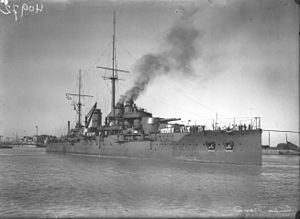Ordered 1 August 1911 Commissioned 15 July 1914 Launched 7 November 1912 Weight 25,580 tons | Namesake France Laid down 30 November 1911 Construction started 30 November 1911 Length 166 m | |
 | ||
Fate Foundered 26 August 1922 | ||
France was the last ship of the Courbet-class battleships, the first dreadnoughts built for the French Navy. She was completed just before World War I as part of the 1911 naval building programme. She spent the war in the Mediterranean, covering the Otranto Barrage in the Adriatic. France, accompanied by her sister ship Jean Bart, was sent to the Black Sea in 1919 to oppose the Bolsheviks during the Russian Civil War. Her crew briefly mutinied in April 1919 from a combination of war-weariness, Communist sympathizers in the crew and difficult conditions. The mutiny and general lack of morale among her crew caused her to return to France later that month. Striking an uncharted rock off the French coast in 1922, she foundered four hours later.
Contents
Description
France was 166 metres (544 ft 7 in) long overall. She had a beam of 27 metres (88 ft 7 in) and at full load a draft of 9.04 metres (29 ft 8 in) at the bow. She displaced 23,475 tonnes (23,104 long tons) at standard load and 25,579 tonnes (25,175 long tons) at full load. She proved to be rather wet in service as she was bow-heavy because of the superimposed turrets forward.
France had four propellers powered by four Parsons direct-drive steam turbines which were rated at 28,000 shaft horsepower (20,880 kW). Twenty-four Belleville water-tube boilers provided steam for her turbines. These boilers were coal-burning with auxiliary oil sprayers. She had a designed speed of 21 knots (39 km/h; 24 mph). She carried up to 2,700 long tons (2,700 t) of coal and 906 long tons (921 t) of oil and could steam for 4,200 nautical miles (7,800 km) at a speed of 10 knots (12 mph; 19 km/h).
France's main armament consisted of twelve 305-millimetre (12 in) Mle 1910 45-calibre guns were mounted in six twin gun turrets, with two turrets superimposed fore and aft, and one on each flank of the ship. For anti-torpedo boat defence she carried 22 138-millimetre (5.4 in) Mle 1910 guns, which were mounted in casemates. Four 47-millimetre (1.9 in) Modèle 1902 Hotchkiss guns were fitted, two on each beam. She was also armed with four 450-millimetre (18 in) submerged Modèle 1909 torpedo tubes with twelve torpedoes.
France's waterline armoured belt extended well below the waterline as the French were concerned about protection from underwater hits. Her main armour was also thinner than that of her British or German counterparts, but covered more area. It was 270 millimetres (10.6 in) thick between the fore and aft turrets and tapered to 180 mm (7.1 in) towards the bow and stern. It extended 2.4 metres (7 ft 10 in) below the normal waterline. Above the main belt was another belt, 180 mm thick, that covered the sides, and the secondary armament, up to the forecastle deck, 4.5 metres (14 ft 9 in) deep, between the fore and aft turrets. The conning tower had armour 300 mm (11.8 in) thick. The main gun turrets had 290 millimetres (11.4 in) of armour on their faces, 250 millimetres (9.8 in) on their sides and roofs 100 millimetres (3.9 in) thick. Their barbettes had 280 millimetres (11.0 in) of armour. There was no anti-torpedo bulkhead although there was a longitudinal bulkhead abreast the machinery spaces that was used either as a coal bunker or left as a void.
Career
France, together with her sister ship Paris, was ordered on 1 August 1911 as part of the 1911 Naval Programme. She was built by the Ateliers et Chantiers de la Loire in Saint-Nazaire. Her keel was laid down on 30 November 1911 and she was launched on 7 November 1912. She was commissioned as part of the Bastille Day celebrations in 1914. Almost immediately after being commissioned, she, escorted by Jean Bart, carried the President of the French Republic, Raymond Poincaré, on a state visit to Saint Petersburg, Russia in July 1914. They returned from Russia shortly before World War I began.
World War I
France, upon her return, was ordered, along with her three sister ships, to serve in the Mediterranean Sea against the Austro-Hungarian and Ottoman Navies. They spent most of 1914 providing gunfire support for the Montenegrin Army until the submarine U-12 torpedoed Jean Bart on 21 December off Sazan Island. This forced the battleships to fall back to either Malta or Bizerte. After the French occupied the neutral Greek island of Corfu in 1916 they moved forward to Corfu and Argostoli, but their activities were very limited as many of their crews were used to man anti-submarine ships.
After the war, France and Paris supported Allied forces in the Black Sea in 1919 during the Southern Russia Intervention. Mutinies briefly broke out on both ships in April 1919, but collapsed when Vice-Admiral Jean-Françoise-Charles Amet agreed to meet their main demand to take the ships home. 26 crewmen were sentenced to prison terms upon her return, although they were commuted in 1922 as part of a bargain between Prime Minister Raymond Poincaré and the parties of the Left. On 26 August 1922, she struck an uncharted rock in Quiberon Bay and foundered four hours later. Of her crew of 900, only three were lost. She was not modernized before her loss.
